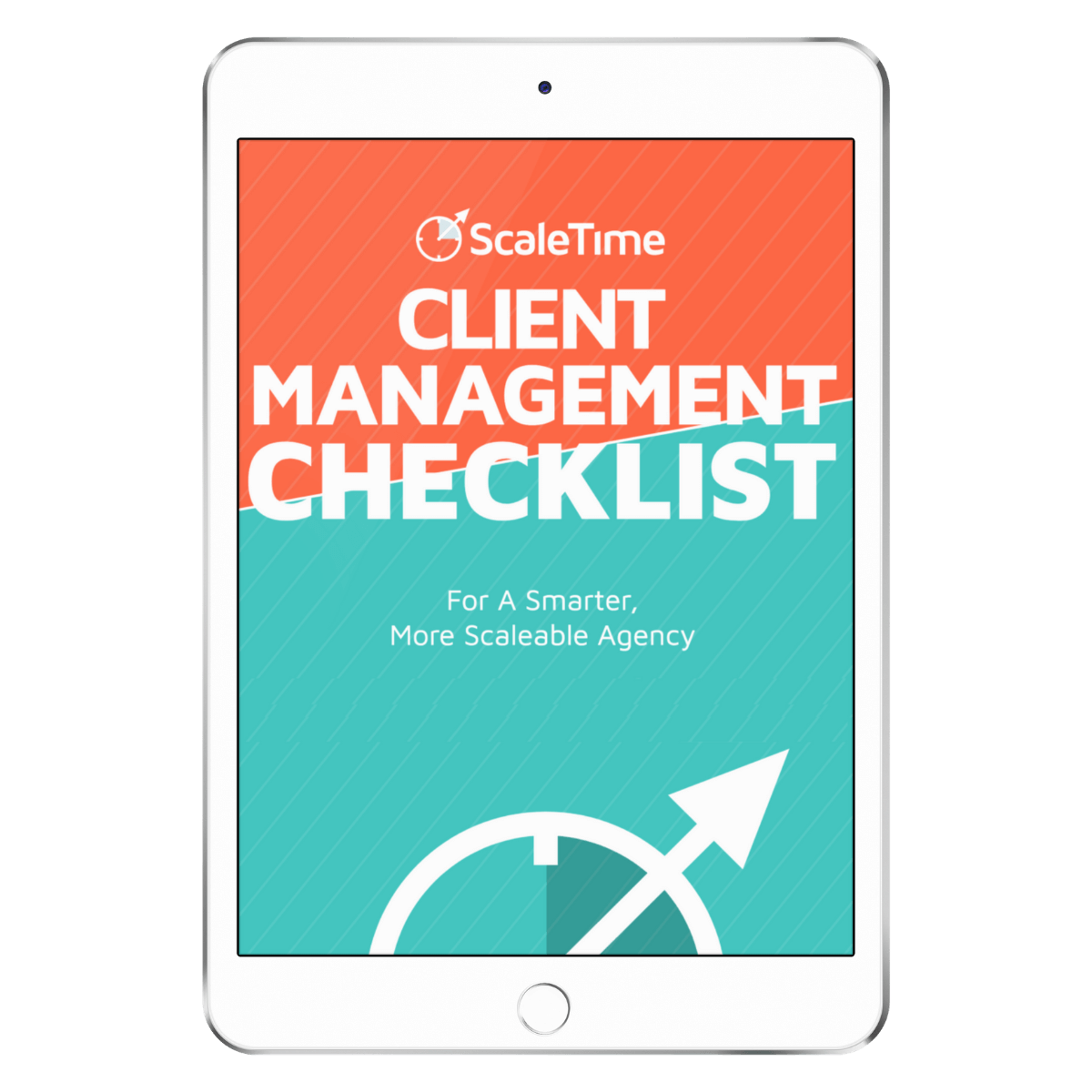A Streamlined Sales Process For Agencies
All That Money on the Table? Get it Every Time with a Predictable, Scalable, and Delegated Sales and Follow Up Process

Give me all the sales! Any client with a pulse is the client for me! That’s how we’ll GROW GROW GROW!
Please just stop right there.
Not every client is a good client — quality matters.
Let’s repeat it for the people in the back:
Quality 👏 matters 👏 in 👏 sales.
Poor-quality sales and stressing out about keeping the lights on will kill your business growth. Chaos will ensue, and chaos isn’t scalable.
So how do you get quality sales in the first place?
With a strategic, streamlined sales process, my friends. Having a laser-focused and airtight sales process in place means you can optimize every single lead for maximum sales, growth, and ROI.
Let’s do this with the SCALE. framework.
What's SCALE.?
Our proprietary SCALE. framework. is a proven process we’ve created to help agency owners tame the wild beast that is external and internal processes.
Why should you care? Because the SCALE. process is what’s going to fireproof your agency against behemoth, cumbersome, lumbering sales processes that cost you time, money, and productivity.
How ‘bout we stop all that like, yesterday? Here’s how SCALE. works to optimize the sales process for yuuuge growth and revenue, effortlessly.

The S in SCALE.
See what’s happening
See what’s happening
Agency owners, do these struggles sound all too familiar?
- Double bookings got you double stressed.
- Proposals keep disappearing into the Bermuda Triangle of Disorganization. Call? What call? Oh sh$t!
- Sales lead follow ups get lost in the shuffle and are gone forever.
- You’re so freaked out about next month’s budget, you’ll take any client who shows an interest.
- Your business keeps having feast or famine cycles, and it’s sapping your enthusiasm and stressing out your team.
- No one knows how to sell as well as you, because well, you’re the owner.
- You know you can increase conversions along the sales process, but are stuck on how to do it.
- You’re freaked out that if you turned on the marketing machine, then your sales engine would sputter and die.
- Every third client you get is a nightmare and a broke as$ bi$ch. (That’s harsh. We know. And we don’t care).
The thing is friend, you can’t fix things if you don’t know exactly what’s broken. The first step in the SCALE. framework is pinpointing precisely where the problems are so you can fix them.
Next, we look at where you are currently with your sales process and establish a baseline.
The C in SCALE.
Create a Baseline
Create a Baseline
Do you feel like you’re losing your mind?
We promise, if you fix your sales process, the problems will go away. And your desperation for a client, any old client, will too. Because when you think you can’t turn away clients, your agency goes from livin’ the dream to trapped in a nightmare.
Or maybe you’re dealing with the opposite problem.
You have all dream clients. But you want more of those and you just haven’t turned on the marketing engine because you’re still the one selling.
So, let’s freshen up your sales process and get rid of that icky feeling for good. Because you know what? You’re the prize, not the other way around.
During this part of SCALE., we’re going to take a laser-focused look at what you’re doing right, what needs tweaking, and establish a baseline of how healthy your current sales processes are.
From here, we’ve got nowhere to go but up.
So what’s the next step? It’s time to pinpoint the good stuff happening in your sales process, optimize, and amplify it.
The A in SCALE.
Amplify how you do it
Amplify how you do it
Think we’ve gotta stop your processes in order to fix them? Well, stop right there cowboy, cowgirl, cowperson. We know you can’t just stop closing sales.
We’re catching this flight in mid-air. During the A part of the SCALE. framework, all the good stuff you’re doing will continue and get amplified. You’ll remain profitable and growing while we fix the sales process.
How so? By:
- Documenting the process so you’re not relying on memory
- Creating a reliable, consistent pipeline
- Seeing where and what the stats are
Once we’ve got your sales process on-point, it’s time for the lead and delegate stage of the SCALE. framework.
The L in SCALE.
Lead and delegate
Lead and delegate
You can’t be the closer with all the coffee. Delegating and tracking metrics means you’ll be handing the reins to the capable people on your team. We’ll show you the best ways to do that.
Because bottom line? You need a delegation process for the sales process to work. They’re like PB&J, Bonnie and Clyde, Abbott and Costello. You get the picture.
As the owner, you’re probably the best sales person on the team. You’re closest to the product and you possess all the ins, outs, and specific knowledge of it.
We’ll show you how to train your sales people so they’re the ones closing with coffee cups full of victory with a capital V. (Because coffee’s for closers.)
That’s one of the most enjoyable parts of owning a business. Keep the money tap on while you get some much-needed balance in your work-life harmony.
Because guess what? The next step is where you get to exit stage right.
The E in SCALE.
Exit and oversee
Exit and oversee
Gracefully or with a bombastic bang, you get to exit from being an active part of the sales process. The final step in the SCALE. framework will get you over the last hurdle to setting up repeatable sales processes that run on autopilot.
No more putting out forest fires. Take a breather and let your business work like a well-oiled machine without you needing to manage it all.
All you have to do now is put on the mantle of relaxed and content overseer. Keep a watch on your metrics so you can see how you’re growing and scaling in real time.
Agencies, Start to SCALE. Your Sales Process
Getting your sales process up and humming along like a well-oiled machine is going to fix so many problems with your business. Mainly, the feast or famine cycle.
With a streamlined and scalable sales process, you won’t be leaving money on the table. You’ll know how much money you’re going to bring in each month. Everyone on your team, even if you’re a solopreneur, is going to know precisely:
- What the offer is
- Who is going to want it
- Who you should sell it to
The result? You get to consistently keep the lights on and work with your dream clients.
ScaleTime’s Sales Process will help you figure out the scalable systems you need to close your ideal customers. Our process will also show you how to delegate parts of the process, freeing up your time.
You’ll learn how to:
- Set goals and understand your metrics
- Track the sales process
- Optimize for growth
- Delegate to a rep
Get started today with our FREE Sales Process Toolkit.
Download the Kick A$ Sales Process Checklist. It’s free.
Get your weekends back with a sales process that can scale your agency.
With a streamlined sales process in place, you’ll eliminate the feast or famine cycle and ensure that you’re only working with good clients who can afford your services.
Contact us today for a free consultation, and you’ll retain employees, increase morale, and scale your agency fast.
They say patience is a virtue. But when it comes to scaling a profitable business, who wants to wait?
Get the goodies NOW with our FREE Sales Process Toolkit.
Why is it so kickas$?
- Not leaving $ on the table = Mo’ Money!
- Start delegating parts of the process so you can close more
- Then be able to hire a rep
- Everybody on the team (even if it’s just you) knows exactly where the deal is
- Know how much money you are going to bring in next month
Getting the sales process right means getting your business right. No more feast or famine, no more crappy clients, no more fretting about keeping the lights on. When you’re done with this section, you’ll have a sales process up and humming along.
Ready to get the goodies? See what’s in the FREE Sales Process Toolkit.
Step 1: Know what you’re selling
If you’re going to create a process for selling, you need to know what you’re selling first. Sounds obvious, but a lot of people overlook this. It goes beyond the physical service, and into the intangibles.
To get clear, create the following:
- List of services with benefits
- List of pain points
- List of pricing
- Definition of how are you different from the competition
- Customer success stories
Step 2: Understand your goals and define your metrics
When you get an understanding of some fundamental sales metrics, you’ll know exactly how much to invest in time and money to achieve your goals.
Document:
- Average sales cycle – length of when the deal starts to when it closes
- Average deal size – the average amount an engagement is sold for
- Monthly revenue – amount of sales collected that month
- Cost of Client Acquisition – cost of all of your sales and marketing expenses over a given period of time, divided by the number of customers acquired in that window
- Closing Ratio – the percentage of closed deals to leads
Step 3: Tracking the sales process
Here’s a visualization of a typical sales workflow:

Step 4: Optimizing the sales process
Qualify Clients
Determine if they are a good fit for your services. It’s the same as having a quick chat on Tinder before meeting up on a date. Gotta filter out the weirdos.
When you adequately qualify clients, you reduce your marketing costs because you’re not wasting time on leads that will never become clients no matter how hard you work. And when your leads are qualified, you can create focused, tailored messaging to really close the deal for the most money as possible.
To qualify clients, it’s important to ask:
- Who are the decision makers?
- What is the budget they need to have to afford your service?
- What are their pain points?
- Why do they need you?
- How long does it take them to make a decision on purchasing from you?
Understand your engagement
So you know which clients are easier and better to work with.
For your clients:
- What is their industry?
- How long do you usually engage with them?
- What is the average revenue per client?
List out the reasons for lost deals in the past
This will allow you to see the patterns of why you or team members are losing deals.
- Is there a new competitor?
- Is there a new technology you are not aware of?
- Are you priced too high? Too low?
- Is there an objection you keep failing to address?
Gain knowledge of client’s seasonality
Some months people buy others they don’t. This will allow you to engage in the right parts of the year to focus and save time and money.
Create templates for proposals and deck presentations
The pitching process can be gruesomely time intensive if you let it be.
To help you improve it, imagine someone else creating a proposal for your business. They would need need:
- A list of pricing and services
- A proposal template
- A list of copy around each service that is being provided for the client
They can then pick and choose what to make.
Step 5: Delegating sales
Passing off sales to a team: How do you find clients?
Activity checklist:
- Referrals
- List of referral partners
- Conferences
- Networking Events
- Seminars
- Speaking Engagements
- Sponsored events
- Skillshare classes
- Lunch & Learns
- Emails
- Cold Calling
What is your sales budget?
Documents and Training Materials:
- Sales Email Templates. Commonly used email templates include:
1. Cold outreach email
2. After a networking followup to schedule an initial meeting
3. A response to a referral
4. Email to schedule a consult or presentation
5. Email with proposal - Scripts / Conversation Frameworks
1. Pitch to an individual
2. Pitch to a group i.e. referral group like BNI
3. Initial meeting
4. Consult / Presentation - Sales material (Decks, sheets etc)
- Sales FAQs: These are questions that can be asked during the sales process at any time to get to know if you are a right fit. Think of these as benign.
- Sales objections: These are malignant – they can kill your deal. Common objections include…
1. I think you are too expensive
2. My last service provider did a horrible job, how do I know you are not going to screw it up?
3. You are really small, how do I know you can handle the volume or deliver on time? - Proposal Template
- Sales Scorecard
- Sales Reports
- Workflows for each of your sales activities
An example in Trello for Networking Events:

Sales Scorecard
Keep track of your sales team activity and results so you are not chasing after them.
Keep track of your sales team activity and results so you are not chasing after them.
Things to include in a scorecard:
- Calls made
- Scheduled meetings
- Qualified clients
- Proposals sent
- Closed deals
Score cards should be reviewed a minimum of once a week with team members.
Tip: you can attach bonuses to scorecard achievements
Tip: you can attach bonuses to scorecard achievements









%20(1).gif)




